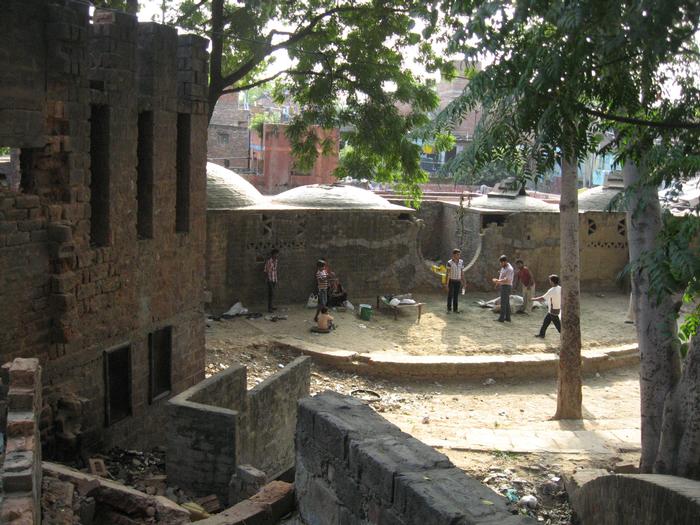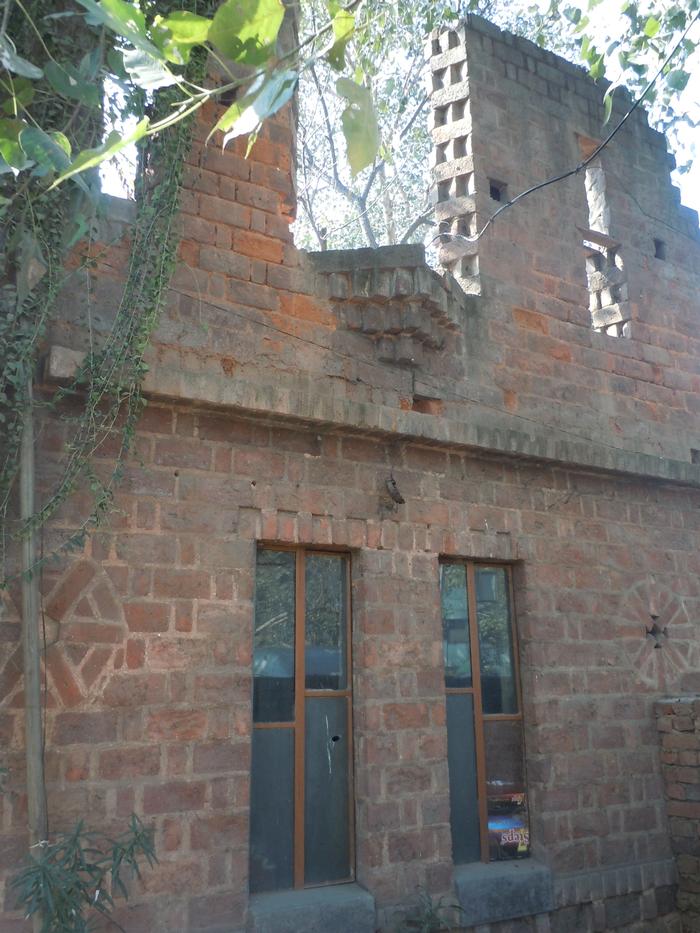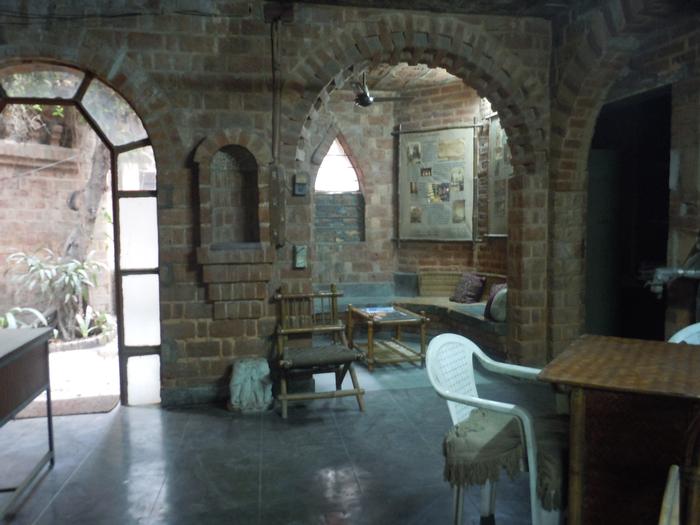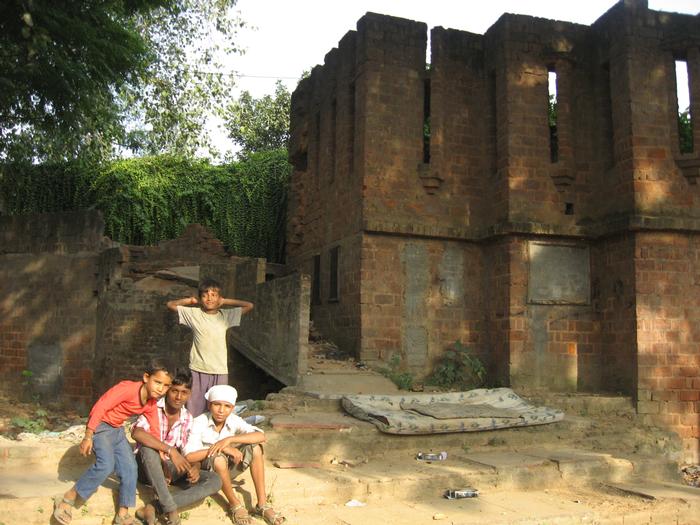[ID:402] Smiling between the cracks - The Laurie Baker Building CenterIndia The tree lined boulevards, swanky malls, the planned condominiums, manicured lawns and the roar of traffic on the arterial highways of Delhi create the perfect image of a global city. But often, there are breaks in this impeccable façade, where the urban fabric becomes torn and derelict. The formalized city is replaced by frugally constructed dwellings crafted from the discards of the “big city”. In one such area, as you drive past tall government housings and institutions, along the main road, you suddenly encounter a large open drain almost as wide as a small stream. Although, unlike a stream it is dirty grey in color and smells of the refuse it carries from these housings. It is almost fitting that the edge of the drain marks the beginning of the Ekta Vihar slum, in which lies the Laurie Baker Building Center. The disorganized, poorly constructed structures of Ekta Vihar, at the edge of the planned developments, speak of a barely tolerated coexistence.
It is often true of shanties that they are forgotten by the city, ignored and erased from the collective memory of the people. Society looks away and pretends that they do not exist. The Laurie Baker Center, a low rise building built by sparingly used exposed bricks, sits amidst the slum perfectly. Among the crowded habitations and narrow lanes where the entire community spills over, the center beckons you and compels a second glance. It demands that you acknowledge this other part of the city.
In the late 1980’s the government body HUDCO (Housing and Urban Development Corporation) came up with a concept of propagating low cost and sustainable construction methods and technologies, by opening up building centers across the country (Laurie Baker Building Centre Home page, 2012). In Ekta Vihar a unique experiment took place, where, as a demonstration, three buildings came up on the land allotted by the Slum Department of the Municipal Corporation of Delhi. One of them was The Rotary Club Vocational Training Center, which imparts training in arts and crafts to the underprivileged. It sits seamlessly within the slum at the side of the drain. Further down the road, the Asha foundation and the Laurie Baker Building Center sit side by side at the entrance to the shanty. The Asha Foundation houses a non government organization (NGO) which provides medical help to the poor. The Center houses a consultancy which gives expert advice on sustainable technologies. It also includes an open air theater that was designed to act as a community space for the marginalized colony. The architect, R D Padmakumar, who was influenced by Laurie Baker, designed these buildings as a temple to his ideals.
Mahatma Gandhi’s thoughts had a great effect on Laurie Baker an English architect. Encouraged by Gandhiji, he settled down in India to practice architecture. Gandhiji preached self-reliance for the country and encouraged local craftsmanship. He advocated the use of locally available materials in all fields of work. One of the things he said about buildings which left a lasting impact on Baker was, “the ideal house in the ideal village will be built of materials which are found within a five mile radius of the home.” (Bhatia, 2000, p. 16)
Baker’s main work was with a missionary organization that took care of patients of leprosy. He had to work and travel extensively in rural India. There he witnessed the lives of the poor first hand and saw how they utilized the limited resources available to them for all their activities, without any wastage. As written by him, “I was increasingly fascinated by the skills of ordinary, poor, village people working with the most unpromising and crude materials with apparently no recognizable tools to make useful everyday buildings and articles” (Baker on 'Laurie Baker' architecture, 2012). Baker’s design slowly evolved, embracing self sustenance, minimal waste and ease of construction. He moved away from elaborate designs and embellishments. Using brick as a base material, he created techniques which were efficient, cost effective and relied on craftsmanship for beauty.
Laurie Baker is best known for his work in rural settings. Padmakumar has transposed his ideas into an urban backdrop, fraught with problems of high population density and severe poverty compounded by very visible and obvious social inequality. Ekta Vihar, being one of the many unauthorized colonies of Delhi, faces the problem of not having formal recognition as a residential area. As a consequence, there is a lack of community space. The Laurie Baker Center is an attempt to create such a space for both the formal and informal activities of the community.
The open air theatre provides the much needed relief space. A series of square rooms, with corbelled domed roofs, sit side by side behind the stage. The walls are mud plastered and have caricatures of birds and animals traced on them by hand. A large circular opening at the center leads to the backstage. Stones are arranged around it like rays emanating from the sun, thus focusing attention on the performers entering the stage. Over the years this theatre has acted like a multifunctional space, molding itself to serve the needs of children and adults alike (Photo 1). As the architect mentions, the space was designed considering the fact that many of the inhabitants of Ekta Vihar were from the desert state of Rajasthan, a place rich in the folk arts (Padmakumar, 2012). It adopts the character of a chaupal (village square) where festivals are celebrated and weddings are performed. Important community meetings are held here when needed, but most often children are seen playing around in the sun.
As the head of the center, Ramesh Kumar, recalls, the space has also played host to many organized activities. College students have rented this place to practice and perform plays, a few of them for the local audience also. Some years ago, a French lady had hired the place for over a year to train people in puppetry. It was most extensively used then, providing fond memories for the children. Training camps for masons and construction workers have been held, where they have been taught how to make bricks in more efficient ways. In addition to the general principles of effective and low cost construction, they have learned techniques distinct to the Laurie Baker style of architecture (Kumar, 2011). Some of these include the rat trap bond, efficient use of filler slabs and the construction of arches and domes for beauty and functionality.
Most importantly the building itself is a demonstration of the architectural principles that the Centre attempts to illustrate. Students of architecture often come here to observe and learn from the building. It is a single storied structure, with a simple layout. Its appeal lies in the exposed brick work which is of such a quality that there is no need for any form of finishing (Photo 2). You enter the building through an arched opening after passing through a small courtyard. The room has a simple square shaped plan which is extended on three sides by archways to form spaces for sitting, utilities and an office. The voussoirs on these arches have been skewed at an angle for aesthetic appeal. The whole structure is supported by them, which negates the need for expensive reinforced beams and columns (Photo 3). Light filters into the room through carefully placed windows, jallis (perforated screens made by removing header bricks in the masonry) and slits in the walls. All walls are constructed using the rat trap bond. In this method bricks are used on edge, with spacing in between, to create voids in the masonry. This reduces the cost of construction by ten to fifteen percent and also provides thermal insulation to the interiors. The roof is made using filler slabs, a system where the unnecessary concrete is replaced by inexpensive filler material. It can be accessed from the open air theatre outside. The walls around the building have been raised as if to form a second floor, but no roof has been given. The evenly spaced voids and slits in the masonry make for a semi-private open space here (Photo 4).
At a time when big city architecture is driven by expensive technology, the centre emphasizes care and simplicity. For an isolated area enveloped by the city, the building has brought in a sense of community by bringing in the familiar characteristics of the village chaupal. In India, the chaupal is the heart of the village. It is the place where panchayats (an assembly of five elders who settle disputes and take decisions regarding the community) are held and all the people gather to celebrate occasions together. The Centre uplifts the lives of a number of people who have migrated to the city in search of work, by reintroducing this traditional aspect into their lives. Acting like a social center, it provides identity and a sense of belonging to these marginalized people. The building arises from the principles with which they live by on a day-to-day basis. Beautiful architecture has been created even with such limited resources. The honest use of materials in its construction, discarding banal embellishments, strikes a chord with these people. It belongs to them and constitutes a place in which they are comfortable. Through the clever use of the common brick, it creates a space which is beautiful because of its austerity. Just like Mahatma Gandhi used to stay with the poor, in the colonies inhabited by the untouchables, living only on bare essentials, the center reflects the identity of these people and is thus accepted by them. It thus becomes a symbol of dignity.
With the approaching Commonwealth Games of 2010, Delhi was playing host and undergoing a major makeover. It saw a wave of ‘beautification’ where slums were hidden away from view by screens along the road, new infrastructure was added and roads were being widened. One such road widening effort claimed the boundary wall of the center. It was left exposed in its vulnerable state for a long time, making it susceptible to vandalism. The open air theater was damaged the most. Where once stood freestanding arches of stability, forming the entrance, now lie heaps of rubble. Even in the main building the walls have been damaged, bricks and reinforcements removed. The broken sun in the middle of the stage becomes an apt metaphor for the defilement of this central space.
Even after the recent battering it has received, the Laurie Baker Center is still central to the community, more so these days as an informal space. But most importantly it holds memories of the days when it was buzzing with activity. The children recall how before the vandalism, the space was used by a lady working for an NGO to teach them songs, dance and theater; and how much they enjoyed performing. But sadly it was stopped due to excessive interference by anti-social elements. However, in such dense areas an open space is never short of users. For instance, during a visit, I saw it being converted into an impromptu veterinary clinic for a horse owned by a resident, Munif (Photo 1). But it is not just about the use, the people’s fondness for the Centre always comes through. Munif rents out his horse for weddings and other occasions. However, when I went there, he happily related to me the workings of the rat trap bond and low cost technology used here. The children showed me around and pointed out the brick designs on the walls. Even though it gets vandalized, people still have an affinity to it. The one thing it lacks is governmental support and recognition.
With change in government policy, the support for the building centers has been stopped. The uniqueness of this center has been neglected. It is obvious that the relevance of a community space still remains. But even then, there have been talks by the local member of the Legislative Assembly (MLA) to replace the open air theater by a playground or a banquet hall. These propositions do not account for all the users of this space and assigning a defined activity would mean destroying its dynamic nature. Most of the residents I spoke to feel that it would be marvelous if the theater could be restored to its original state, but fear that it might get vandalized again.
The simplicity of the Center’s design ensures that it can be very easily and inexpensively restored once such a decision is taken. Such institutions may have a fragile nature, but that needs to be recognized and nurtured. However, there are no provisions for its support as the government’s policy has changed. Although the government was the reason for the genesis of the building, the same may become the cause for its demise.
Such institutions are needed even more today. The rapidly urbanizing societies are facing an increasing influx of migrants, who are confronted with the problems of anonymity, rootlessness and conflict apart from economic strains. The Center has become a demonstration of how a building can become part of a living community and provide a positive space to people who have no place to call their own. It is part of the legacy of architecture for the public good in India. It draws from Gandhian philosophy and Laurie Baker’s ideas and tackles urban problems in new settings. It sets an important example from which a lot can be learned.
Works Cited
Baker on 'Laurie Baker' architecture. (2012). Retrieved January 6th, 2012, from www.lauriebaker.net.
Bhatia, G. (2000). Laurie Baker, life, work, writings. Penguin Books India.
Kumar, R. (2011, October 8). The usage of the Laurie Baker Building Centre over the years. (S. Sinha, Interviewer)
Laurie Baker Building Centre Home page. (2012). Retrieved January 6th, 2012, from www.lauriebakerbuildingcentre.com.
Padmakumar, R. (2012, January 22). The design of the Laurie Baker Building Centre. (S. Sinha, Interviewer)
If you would like to contact this author, please send a request to info@berkeleyprize.org. |




